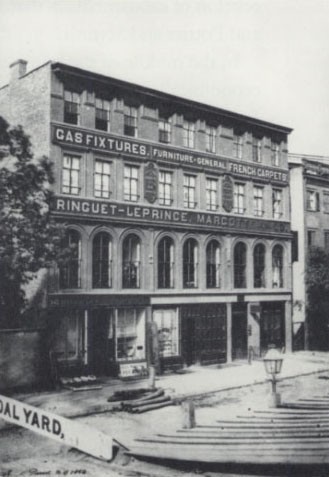
Ringuet-Leprince, Marcotte and Co. shop, 343–347 Fourth Avenue, New York, 1854. The showroom was separate from the factory, which was located at 55 West 16th Street. (Collection of the New-York Historical Society.)
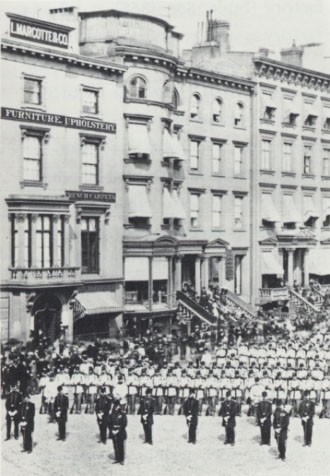
Marcotte & Co. shop, 29 East 17th Street, New York, ca. 1865. The Marcotte shop was an elegant beaux arts building located on Union Square just off Fifth Avenue, a fashionable address for the period.(Collection of the New-York Historical Society.)

Armchair attributed to Auguste-Émile Ringuet-Leprince & L. Marcotte, New York or Paris, ca. 1845. Applewood or pearwood, ebonized walnut, beech, and gilt bronze mounts. 38 1/2" x 23 1/4" x 26 1/8". (The Metropolitan Museum of Art, Gift of Mrs. Douglas Williams, 1969, acc. 69.262.3.) All rights reserved, The Metropolitan Museum of Art.

Ballroom in Chateau-Sur-Mer, Newport, Rhode Island. (Courtesy, Preservation Society of Newport County.)
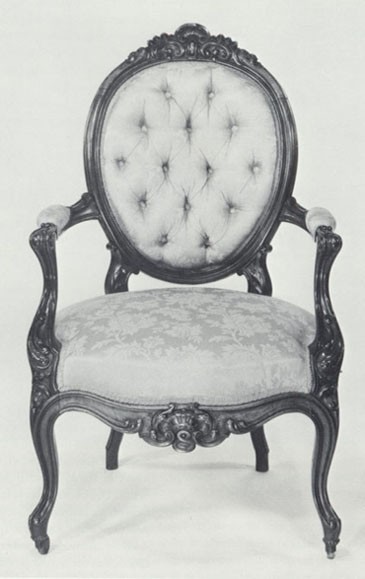
Armchair by Ringuet-Leprince & L. Marcotte, New York, 1856–1857. Rosewood. H. 38 1/2", W. 24 1/2", D. 22 1/2". (Courtesy, Armsmear; photo, E. Irving Blomstram.)

Center table attributed to L. Marcotte & Co., New York, ca. 1865. Beech with hickory, aspen, white pine, and oak. H. 30 1/2", W. 51 1/2", D. 37 1/2". (Brooklyn Museum, acc. 86.4.)
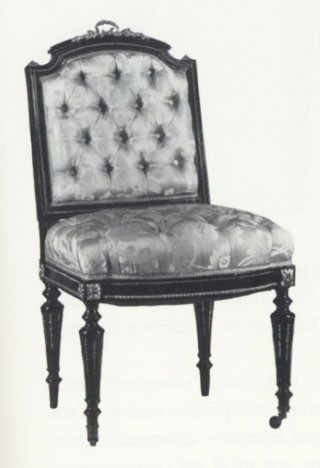
Side chair from a set of six attributed to L. Marcotte & Co., New York, ca. 1860. Maple with pine. H. 37 3/4", W. 20 3/4", D. 17 1/2". The tufted silk upholstery, four fluted legs, and high-quality mounts all show that this was one of the fancier suites of Louis XVI furniture. (The Metropolitan Museum of Art, Gift of Mrs. D. Chester Noyes, 1968, acc. 68.69.6–11). All rights reserved, The Metropolitan Museum of Art.
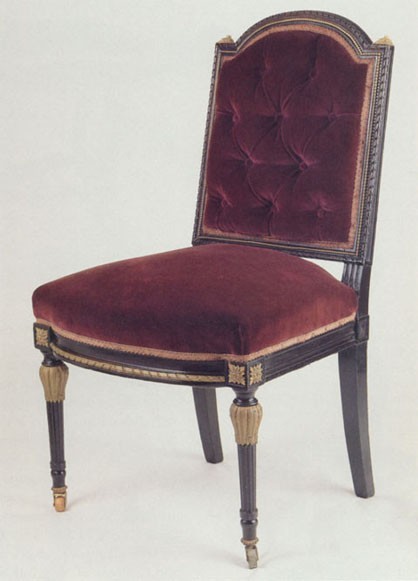
Side chair attributed to L. Marcotte & Co., New York, ca. 1865. Beech. H. 36 1/2", W. 20 1/4", D. 16 1/2". (Private collection; photo, Gavin Ashworth.)

Armchair attributed to L. Marcotte & Co., New York, ca. 1865. Beech. H. 38 1/4", W. 21", D. 19 3/4". (Private collection; photo, Gavin Ashworth.)
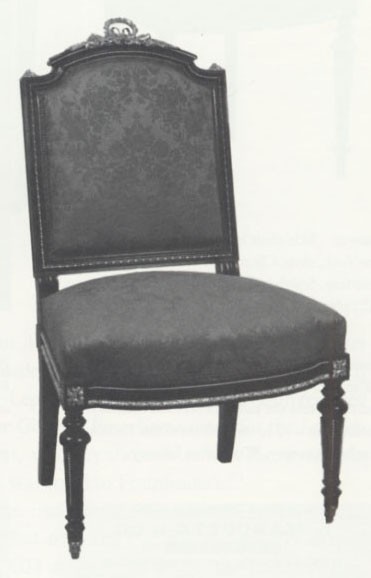
Side chair attributed to L. Marcotte & Co., New York, ca. 1860. Beech. H. 38", W. 21 3/4", D. 19". (Private collection; photo, Glenn Castellano.)
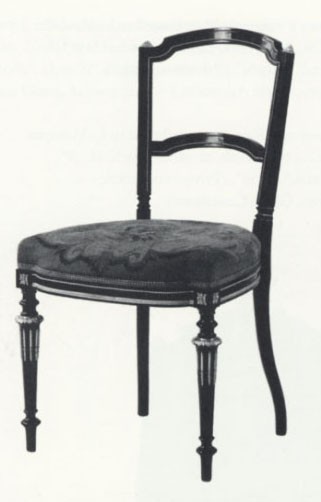
Side chair by L. Marcotte & Co., New York, 1869. Cherry. H. 33 1/2", W. 18", D. 18". (Courtesy, Smithsonian Institution, Washington, D.C.; photo, Peter Hill.)
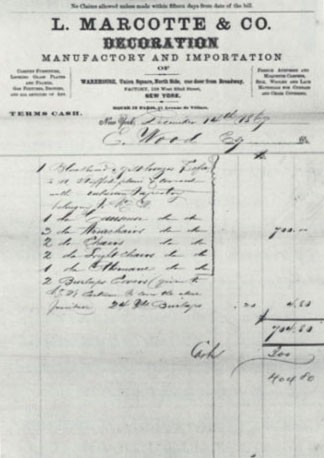
Bill of sale from L. Marcotte & Co. to Eliphalet Wood, New York, 1869. The bill head delineates the range of services offered by Marcotte, as well as the address of the Parisian branch. (Courtesy, Winterthur Library.)
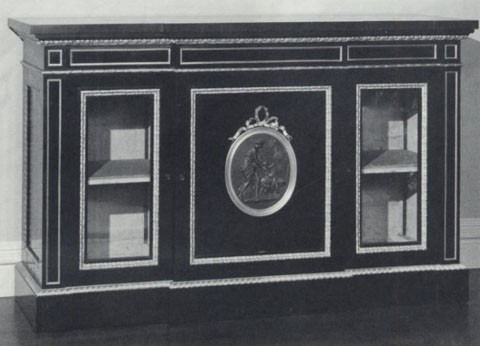
Cabinet attributed to L. Marcotte & Co., New York, ca. 1860. Oak, poplar, pearwood and applewood veneer. H. 42 7/8", W. 72 3/16", D. 21 1/4". (The Metropolitan Museum of Art, Gift of Mrs. Douglas M. Moffat, 1968, acc. 68.165.1a,b.) All rights reserved, The Metropolitan Museum of Art.
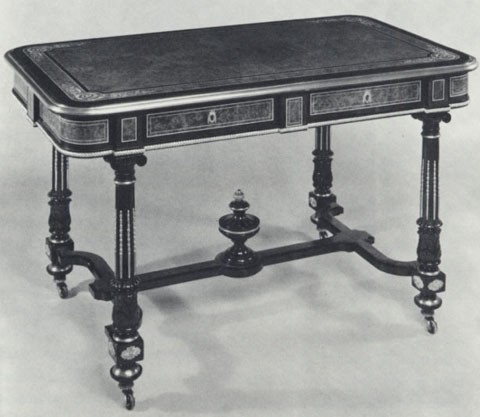
Library table attributed to L. Marcotte & Co., New York, ca. 1860-1872. Walnut, amboina pine, maple, poplar, ash, cherry, hornbeam . H. 30 3/4", W. 50", D. 29". (The Metropolitan Museum of Art, Gift of Mrs. Robert W. de Forest, 1934, acc. 34.140.1.) All rights reserved, The Metropolitan Museum of Art.
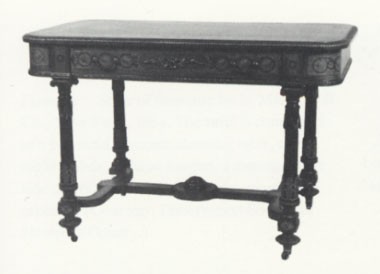
Library table attributed to L. Marcotte & Co., New York, ca. 1870. Walnut, burl walnut veneer, and satinwood with oak and fruitwood. H. 30 7/8", W. 47", D. 27 1/8". (Private collection; photo, Glenn Castellano.)
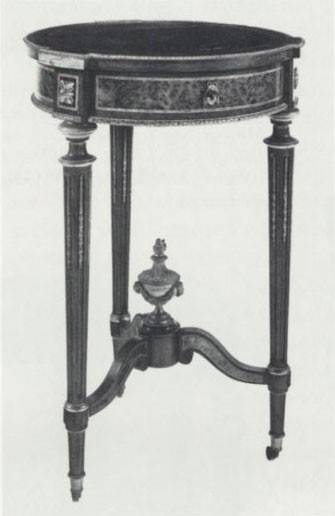
Work table by L. Marcotte & Co., New York, 1869. Walnut and burl walnut veneer. H. 27", Diam. 18 1/2". This table is particularly “French” with delicately proportioned legs joined by a gracefully curved stretcher. (Photograph by David Bohl in addition to Courtesy of the Society for the Preservation of New England Antiquities, acc. 1969.2126.)

Engraving of a sideboard made by Ringuet-Leprince & L. Marcotte for the Crystal Palace Exhibition, New York, 1853. (Silliman and Goodrich, The World of Science, Art and Industry, [New York, 1853], p. 47.)
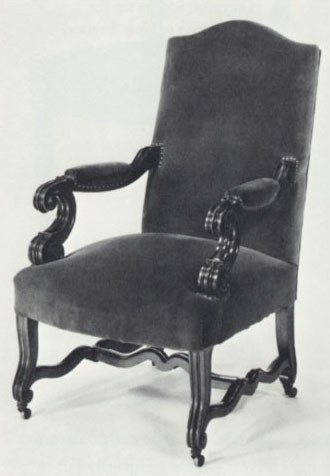
Chair by Ringuet-Leprince & L. Marcotte, New York, 1857. Oak. H. 44 1/2", W. 25 1/2", D. 25 1/4". (Courtesy, Armsmear; photo, E. Irving Blomstram.)
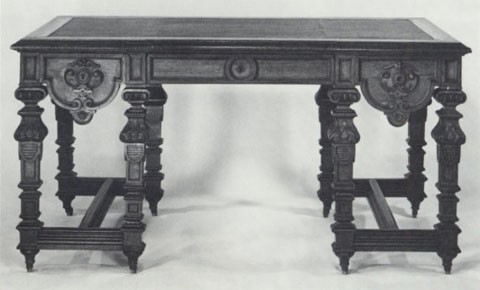
Desk by Ringuet-Leprince & L. Marcotte, New York, 1857. Walnut, oak, and mahogany with pine. H. 30", W. 60", D. 34". (Courtesy, Armsmear; photo, E. Irving Blomstram.)
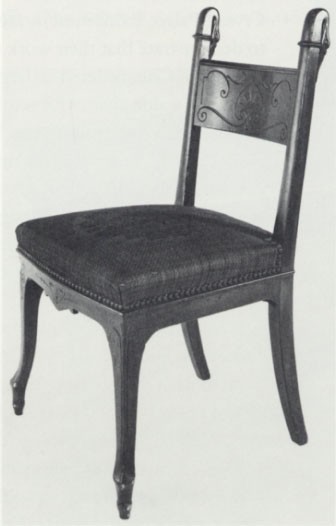
Side chair by L. Marcotte & Co., New York, 1862. Butternut. H. 35 1/4", W. 18 3/4", D. 18 1/2".( Photograph by David Bohl in addition to Courtesy of the Society for the Preservation of New England Antiquities, acc. 1969.767.1; photo, David Bohl.)
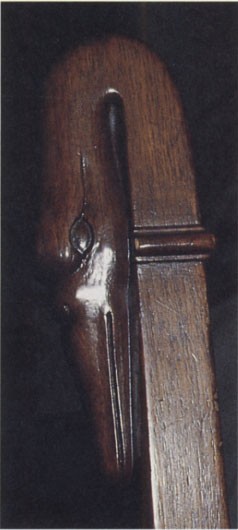
Detail of the side chair illustrated in fig. 20. (Photo, Nina Gray.)
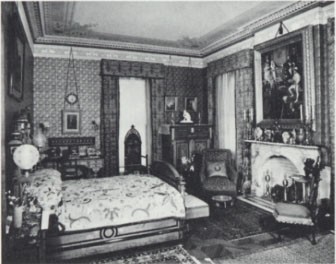
Suite of furniture by L. Marcotte & Co., New York , 1869. The suite is composed of a bedstead, armoire, dressing table, two night stands, a chaise longue, a commode, six side chairs, a linen press, and two wardrobe cabinets. (Courtesy, Preservation Society of Newport County.)
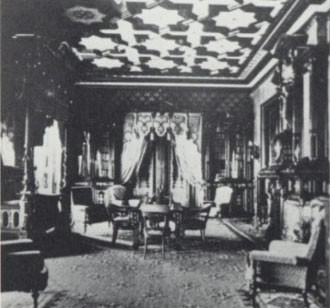
Library in the LeGrand Lockwood mansion, Norwalk, Connecticut, photograph ca. 1870. Financial and railroad entrepeneur, LeGrand Lockwood built the house in 1869. The divan and looking glass are on the left. (Courtesy, Lockwood Matthews Mansion.)

Detail of the library in the Lockwood mansion. The ceiling is particularly elegant and illusionistic in the manner in which the eight pointed stars surround the crosses. The blue and gold wallpaper is embossed like Moroccan leather. (Courtesy, Lockwood Matthews Mansion; photo, Gavin Ashworth.)

Engraving of a cabinet by L. Marcotte & Co., New York, 1878. (Art Journal, 1878.)
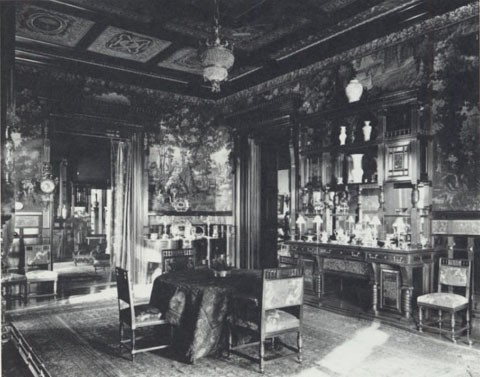
Dining room in the McCormick mansion, Chicago, 1880. The walls were covered with antique tapestry and the seating was upholstered with green stamped leather. (Courtesy, State Historical Society of Wisconsin.)
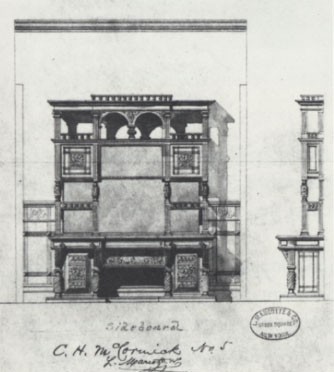
Drawing of a sideboard by Leon Marcotte, New York, 1877. Pencil on paper. (Courtesy, State Historical Society of Wisconsin.)
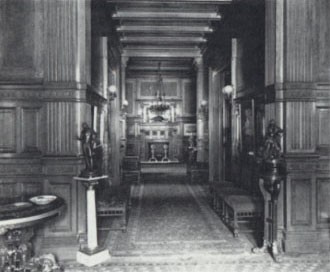
Hall in the McCormick mansion, Chicago, 1880. (Courtesy, State Historical Society of Wisconsin.)
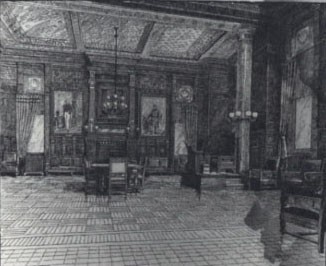
Board of Officers Room in the Seventh Regiment Armory, New York, 1880. (Woodcut from the Decorator and Furnisher, May 1885. Courtesy, Seventh Regiment Fund; photo, Gavin Ashworth.)
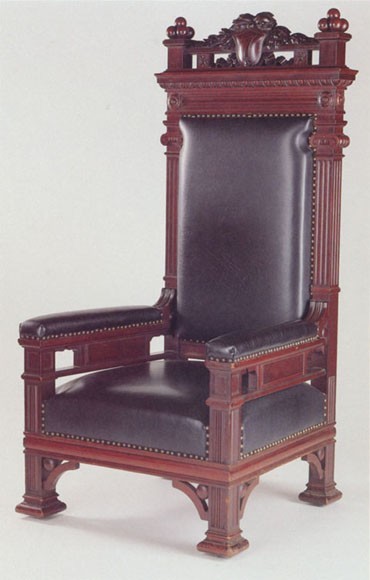
Presiding officer’s chair by L. Marcotte & Co., New York, 1880. Mahogany. H. 64", W. 31", D. 29". (Courtesy, Seventh Regiment Fund; photo, Gavin Ashworth.)

“Mexican” chair by L. Marcotte & Co., New York, 1869. Ebonized wood. H. 35 1/2", W. 20 1/2", D. 30". The plump scroll on the curve of the back is typical of Marcotte’s work. (Photograph by David Bohl in addition to Courtesy of the Society for the Preservation of New England Antiquities, acc. 1969. 2908.)
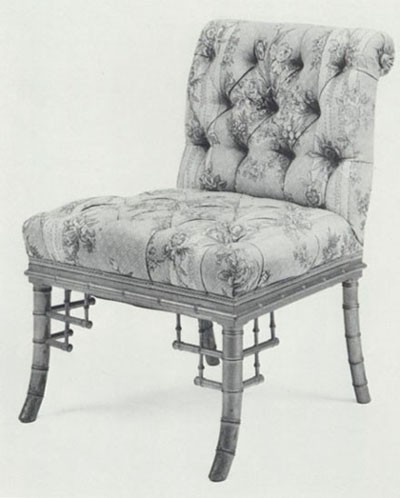
“Chinese” side chair by L. Marcotte & Co., New York, 1869. Gilded wood. H. 28 5/8", W. 20 1/4", D. 20 7/8". (Photograph by David Bohl in addition to Courtesy of the Society for the Preservation of New England Antiquities, acc. 1969.3528.)
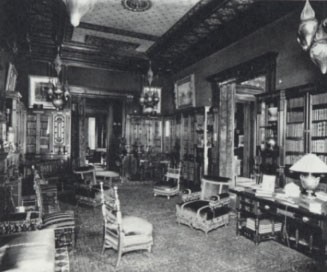
Library in the McCormick mansion, Chicago, 1880. (Courtesy, State Historical Society of Wisconsin, photo ca. 1880.)
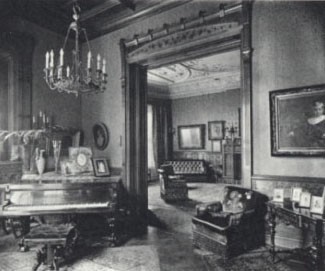
Music room in the McCormick mansion, 1880. (Courtesy, State Historical Society of Wisconsin, photo ca. 1880.)
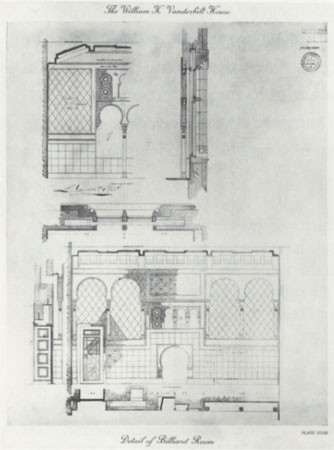
Billiard room in the William K. Vanderbilt house, New York, 1882–1883. (Illustration from John Vrenburgh Van Pelt, A Monograph of the William K. Vanderbilt House [New York: privately published, 1925], pl. 18.)
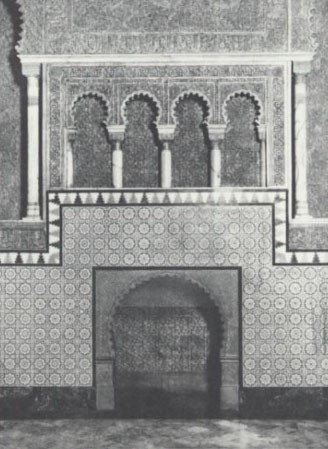
Billiard room in the William K. Vanderbilt house, New York,1882-1883. (Illustration from John Vrenburgh Van Pelt, A Monograph of the William K. Vanderbilt House [New York: privately published, 1925], p.58.)
Here, for instance, is my house. . . . It is superbly furnished. Mrs. P. and I don’t know much about such things. She was only stringent for buhl, and the latest Parisian models, so we delivered our house into the hands of certain eminent upholsterers to be furnished, as we send Frederic to the tailor’s to be clothed. To be sure, I asked what proof we had that the upholsterer was possessed of taste. But Mrs. P. silenced me, by saying that it was his business to have taste, and that a man who sold furniture naturally knew what was handsome and proper for my house. . . . The furnishing was certainly performed with great splendor and expense. . . . They are there, because my house was large . . . and because, as Mrs. P. says one must have buhl and or molu, and new forms of furniture, and do as well as one’s neighbors, and show that one is rich.[1]
In this passage of The Potiphar Papers, George William Curtis expressed the intense desire felt by many mid-nineteenth-century New Yorkers for the most stylish furniture and decoration. Curtis’s characterization of the “eminent upholsterer” capable of supplying “the latest Parisian models” fits an interior decorator such as Leon Alexandre Marcotte, renowned in his own day as a decorator and cabinetmaker whose clientele included the affluent and sophisticated elite of New York. Marcotte was among the upper echelon of cabinetmakers that included Herter Brothers, Alexander Roux, and Pottier and Stymus.
In the middle of the nineteenth century, New York was full of promise economically and culturally. Wealthy New Yorkers were enthusiastic for the French styles and fashions that they encountered in their trips abroad. As New York flourished financially, the demand for French articles grew, reflecting the influence of imports, immigrant tradesmen, and French-trained architects and designers.[2]
Marcotte was in a fine position to succeed in New York because of his partnership with Auguste-Emile Ringuet-Leprince (heir to a dynasty of French ébénistes), his knowledge and training in French design, and his connections with Paris, assuring his clients of the very latest style. Although a contemporary cabinetmaker, Ernest Hagen, wrote that “Marcotte and Co. worked principally in the pure Louis XVI style and . . . [did] the very best work,” the firm was proficient in many of the successive revivalist styles that dominated the latter part of the nineteenth century.[3]
Leon Marcotte, born on May 15, 1824, in Valognes, Manche, France, attended the École des Beaux Arts and trained as an architect in the studio of the leading neoclassical, rationalist architect, Henri Labrouste. While working for Labrouste, he probably met Danish-born architect Detlef Lienau. Lienau and Marcotte both came to New York in 1848, and several years later, they became business partners. Marcotte’s architectural background and training were an important foundation for the part of his business that encompassed interior architectural work and decoration. His furniture designs also have an architectural quality marked by particularly fine proportions.[4]
Marcotte’s involvement with the furniture making trades began by the time that his sister, Marie-Felicité, married Parisian ébéniste Auguste-Emile Ringuet-Leprince in 1835. Ringuet-Leprince’s reputation was well established through his descent from a line of ébénistes dating back to the late eighteenth century and through the prestige he gained by winning a bronze medal for a buhl table, an armchair, a priedieu, and a side cabinet at the 1844 Universal Exposition in London. During the 1840s Ringuet-Leprince built up a strong client base and network of referrals from wealthy Americans who bought furniture and decorations from him in Paris. One of Ringuet-Leprince’s earliest American clients was Mathew Morgan of New York, who in 1842 redecorated his parlor in the Louis Quartorze style and subsequently advised his friend James Colles that Ringuet was “a man of good taste in his line.” Other wealthy New York clients during the 1840s included Mrs. Samuel Jaudon, a Mrs. Henderson, a Mr. Deacon, and Delancy Kane, all of whom moved in the same social circle. Colles was an especially valuable client since he referred his friends to the Parisian establishment and promised Ringuet-Leprince, “We shall cheerfully continue to commend you to our friends whenever an opportunity offers. We are pleased and satisfied with various articles you have furnished us: they are in excellent taste and we thank you for your care and attention.” The issue of good taste was an important one, as Mrs. Jaudon explained: “We on this side feel as if everything was so much hansomer, and better, and desirable that comes from Paris.”[5]
Ringuet-Leprince’s prosperity was based on the wide range of services he provided, including furniture, tapestries, curtains, ornamental architectural elements, carpets, bronzes, and chandeliers, as well as advice concerning the overall effect of a room. In short, he acted as a decorator, albeit long distance. The 1848 revolution adversely affected his local trade, so Ringuet-Leprince focused his attention on the more promising New York prospects. On March 30, 1848, he wrote Colles:
My intention . . . is to go in the autumn with my brother in law who is an architect. . . . Our business would be first to give projects for townhouses or any construction whatever. Second to make the inside decorations in papier maché or paper or carved wood. Third to furnish them with any kind of furniture from my factory in Paris, Aubusson, Lyon etc., after choice of my designs, patterns, etc.
Ringuet-Leprince and his brother-in-law, Marcotte, arrived in New York sometime toward the end of 1848 and set up business on lower Broadway. Marcotte was put in charge of the New York branch, Ringuet-Leprince returned to France, and a third man traveled between the two to fill the orders. [6]
It is possible to reconstruct the business, known successively as Maison Ringuet-Leprince (1840–1849), Ringuet-Leprince & L. Marcotte (1849–1860), and L. Marcotte & Co. (1860–1918), through the Paris and New York city directories, the New York copartnership directories, the credit ledgers of R. G. Dun, the 1855 New York census, and various receipts and personal documents. During the 1850s, Ringuet-Leprince & L. Marcotte relocated several times both in Paris and New York (fig. 1). The variety of professional titles, services, and products listed in the directories is broad: architect, cabinetmaker, decorator, furniture dealer, rug dealer, supplier and maker of bronzes, exporter, commissioned merchant in deluxe furnishings as well as in papers (presumably wallpapers), silk, woolen and lace materials for curtains and chair coverings, gas fixtures, chandeliers, art furniture, looking glass plates, and tapestries. In New York, Marcotte was in partnership with Detlef Lienau from 1851 to 1854.[7] Lienau subsequently designed Marcotte’s factory and store (fig. 2) and worked with him on the Lockwood Mathews mansion in Norwalk, Connecticut.
In 1852 (Étienne Simon Eugène) Roudillon was listed in the Paris city directory as the successor to the Maison Ringuet-Leprince; however, Ringuet-Leprince was listed at the same address until 1858. The double listings suggest that Ringuet-Leprince found his New York business more promising and relinquished his French trade to Roudillon, while maintaining the Paris shop and/or factory solely for export purposes. This interpretation is supported by post-1858 Paris directories that list Ringuet-Leprince as a commissioned merchant.[8]
Bill headings specify that the Paris business operated under the name Ringuet-Leprince and that the New York branch was Ringuet-Leprince and Marcotte. The 1855 New York census valued the building at 347 Fourth Street at $17,000. Living with Marcotte were his younger brother Charles, who was also a cabinetmaker, his mother, and a French-trained cabinetmaker, Augustus Fredin. Fredin is listed as a partner with Marcotte and Ringuet-Leprince in the copartnership directories from 1853 to 1857. The R. G. Dun appraisals began in 1854, and approximately every six months a representative called on Marcotte to write an evaluation and commentary on the business. The first entry on Ringuet-Leprince and Marcotte reveals that they imported both plain and “rich” furniture, but that a majority of their work was “ornamenting houses.” The report valued the business at $50,000, noted the firm’s potential for expansion, and described Marcotte as smart and reliable with “much artistic taste” and business acumen. The following year Dun reported that Ringuet-Leprince and Marcotte employed 150 second-class hands. By 1858 Ringuet-Leprince and Marcotte reportedly made “first class work for the best and wealthiest clients, at their own prices,” and showed a large profit.[9]
With business thriving, Marcotte turned his attention to personal matters. On May 23, 1859, he married Louise-Marie de Rudder, the daughter of a Parisian painter. Their marriage certificate stated that Marcotte was residing in Paris. He may have been there making arrangements to assume the added responsibility of Ringuet-Leprince’s approaching retirement.[10]
In July 1860, Ringuet-Leprince retired and the firm name changed to L. Marcotte & Co., with Marcotte in charge. Throughout the 1860s, the firm reported excellent profits, had good customers, and maintained good standing in the business community. In 1866, the Mercantile Agency (a forerunner to Dun and Bradstreet) gave L. Marcotte & Co. a high credit rating and estimated the pecuniary strength of the firm to be $50,000/$100,000. By 1869, this figure rose to $100,000, reflecting the growth of the company and the addition of a new factory (built 1867–1868) at 158–164 West 32nd Street. Lienau designed the factory as well as the shop and showroom built two years later (see fig. 2).[11] As this was a time of great expansion, Marcotte and Ringuet-Leprince made Adrian Herzog a partner in 1868. Herzog remained with the company until his death in the early 1890s.
The firm continued to grow rapidly during the 1870s, and R. G. Dun frequently described L. Marcotte & Co. as an “old and well established house” or an “old rich house.” In 1874 the firm did $200,000 worth of business, and in 1878 it had stock valued at $200,000 and outstanding invoices totaling $50,000. Ringuet-Leprince sold his interest the following year, and Marcotte decided to make Paris his permanent residence, although he spent equal time in New York.[12]
Back in France, Marcotte advertised the services of the Parisian branch in great detail and relocated the shop from Avenue de Villars 15 to the more fashionable Avenue de l’Opera 11. In 1882, the New York branch followed suit by moving to 298 Fifth Avenue at 31st Street. R. G. Dun estimated the strength of the business to be $200,000 to $250,000, despite “strong competition” from other leading decorating firms such as Herter Brothers and Pottier and Stymus. The high ratings continued throughout the 1880s. Leon Marcotte died on January 25, 1887, in Paris at the age of 62, but L. Marcotte & Co. continued under the direction of Adrian Herzog and his family in New York and Edmond Leprince Ringuet in Paris. The last listing for the firm in Paris is 1911. The New York branch moved to Long Island City in 1918 and went out of business by 1922.[13]
During the last half of the nineteenth century, Marcotte’s firm kept pace with what was fashionable and in demand. Most of the styles were historic revivals, but they were interpreted in a very distinctive manner. Included were the Louis XIV, XV, and XVI styles, all based on eighteenth-century French models, and the Renaissance revival, an eclectic blend of Henri II, François I, and Louis XIII styles. The aesthetic style—another important artistic movement of the late nineteenth century—was considerably more diverse, incorporating elements of Far Eastern, Middle Eastern, and European design. While R. G. Dun’s ledgers and the Mercantile Agency show that Marcotte’s firm did a tremendous amount of business, only a small portion of this work is documented by bills of sale and correspondence or attributable through connoisseurship.
Marcotte and Ringuet-Leprince are best known for their interpretations of the Louis XV and Louis XVI styles in a broad range of forms, each of which was offered at a variety of levels to accommodate different tastes and budgets. An armchair from a suite of two sofas, two armchairs, four side chairs, a center table, and a firescreen made for John Taylor Johnston, the first president of the Metropolitan Museum of Art, is a fine example of the firm’s Louis XV-style furniture (fig. 3). The style was the last phase of the rococo revival, and Ringuet-Leprince & L. Marcotte’s interpretation was particularly refined. A distinctive feature of their furniture is the almost spherical shape of scroll feet. Possibly imported from France, the elegant chased mounts on the Johnston chair are exceptional even for the firm’s finest work. Johnston’s father-in-law, James Colles, may have recommended Marcotte and Ringuet-Leprince to the Johnstons when they began decorating their new home on Fifth Avenue and 8th Street. Johnston was an important client for Marcotte; he was a central figure in New York society, and his family was a continual source of patronage.
William Shepard Wetmore of Newport, Rhode Island, and Samuel Colt of Hartford, Connecticut, also purchased Louis XV-style furniture. Wetmore was a wealthy New York City banker and merchant who retired about 1850 and hired architect Seth Bradford to built his Newport mansion, “Chateau-Sur-Mer.” He commissioned Marcotte to design a suite of ebonized Louis XV-style furniture—four sofas, four armchairs, and eight side chairs—for the ballroom (fig. 4).[14] The gold floral brocade upholstery complemented the gilt-bronze mounts on the furniture and the gilt highlights on the shaded grey walls. Although based on Louis XV furniture, Marcotte altered the proportions to suit the nineteenth-century taste for robust, florid forms and broke from eighteenth-century tradition by using ebonizing and ormolu mounts on seating furniture.
Marcotte’s work for Samuel Colt’s house, “Armsmear,” included architectural elements, furniture, upholstery fabrics, draperies, carpets, chandeliers, and lamps for the drawing room, dining room, office, library, bedrooms, and a dressing room. The New York shop made the furniture and architectural components, and the Paris shop furnished many fabrics and lighting devices. After receiving a letter from Marcotte advising him to “call at our establishment where you will find my brother-in-law to your entire disposition,” Colt traveled to Paris and ordered two carpets, five chandeliers, and two lamps from Ringuet-Leprince. On November 26, 1856, Marcotte advised, “The parlour set of furniture same as the dining room are very nearly finished. This last one however I cannot complete as you have decided upon different covering in Paris. . . . For the three bedrooms of the second story I am hurrying the work as fast as possible but I have only one set of mahogany furniture ready. If you would decide to have your bedroom furnished with rosewood I could send you a set at once.” Colt chose the rosewood suite, about which Marcotte assured him, “We have calculated to have everything substantial and made in the best manner and not too elaborate.” There is more ornamental carving on the rosewood parlor furniture than on the ebonized suites with gilt-bronze mounts, as if Marcotte compensated for the absence of applied, gilded ornament (fig. 5).[15]
Henry Marquand, another of Marcotte’s socially prominent New York clients, was the second president of the Metropolitan Museum of Art and may have been introduced to Marcotte by John Taylor Johnston. Marcotte probably made the center table illustrated in figure 6 for Marquand’s Madison Avenue mansion. The table has an exceptionally bold stretcher and sculptural mounts that envelop the scrolled legs.
Marcotte’s business blossomed with the growing popularity of the Louis XVI style in the 1860s and 1870s. As late as 1878, Harriet Spofford wrote, “Louis Seize is again the favorite of that fashion. . . . It is as well suited to the frivolities of the life too frequently led nowadays by the extraordinarily wealthy as more stable and solid and dignified furniture could.”[16] Several of Marcotte’s old clients, including Johnston, ordered new suites of Louis XVI-style furniture. The side chair illustrated in figure 7 is from a large suite—two sofas, six side chairs, two lyre-back chairs, two armchairs, a firescreen, two single-door side cabinets, and a three-door side cabinet—made for Johnston’s music room about 1860. As the chair demonstrates, Marcotte’s Louis XVI-style pieces are typically richer and bolder than their eighteenth-century counterparts, and they often have gilt-bronze beading emphasizing the silhouettes.
A number of Louis XVI suites by L. Marcotte & Co. have survived. Although there are differences in the mounts and carving, there is little variation in the proportions and dimensions of each furniture form. The chairs illustrated in figures 8 and 9, for example, are virtually identical in measurement to other Louis XVI-style chairs documented to L. Marcotte & Co., but they have several unique features. The crest rails have a single arch rather than the usual Chapeau de Gendarme shape (reverse curve), and the twisted column arm supports, carving, and gilt-bronze mounts are very distinctive.
Marcotte’s establishment offered several lines of furniture. At the high end were custom-designed pieces, such as those commissioned by Colt, and in the middle range were items or suites of furniture that could be embellished with a variety of structural and decorative options: turned and fluted legs, carving, gilt-bronze mounts, and expensive upholstery fabrics and details (compare figs. 7 and 10). This sort of semi-custom work probably accounted for a substantial portion of his business.
A Louis XVI side chair made by Marcotte for Eliphalet Wood of Irvington, New York, has extraordinary covers that Wood purchased at Aux Genre Gobelins in Paris, while on a grand tour of Europe in 1869 (fig. 11). After deciding that a Marcotte suite purchased second hand through Sypher and Company of New York was not suitable for the upholstery, Wood ordered a new suite from Marcotte (fig. 12). Except for the absence of a gilt-bronze bow-knot in the center of the crest rail, the chairs from Wood’s second suite are identical to those from two other suites by Marcotte—one in the Metropolitan Museum of Art and the other in the Lockwood Mathews Mansion Museum. Wood’s open-back side chair is an extremely elegant form marked by the repetition of the Chapeau de Gendarme shape. Marcotte used the term “Light Chair[s]” to describe open-back examples of this general form.
Whereas Marcotte’s Louis XVI seating furniture was unmistakably nineteenth century, his designs for case pieces were more faithful to eighteenth-century prototypes. The earliest Louis XVI-style casework documented to Ringuet-Leprince & L. Marcotte is a marble-top rosewood cabinet with gilt-bronze mounts made for the drawing room at Armsmear for which Colt paid Leprince and Marcotte $280 in March 1857. The cabinet is similar in form to one L. Marcotte & Co. made three years later for John Taylor Johnston as part of a suite of three cabinets, all of which closely resemble French neoclassical forms (fig. 13). These parallel the 1860 Marcotte and Ringuet-Leprince advertisement offering “rich suites of Black Wood and Gilt” and “Black and Gilt Carved Centre Tables with . . . elegant Cabinets to Match.”[17]
A library table with a history of ownership by Johnston’s daughter, Emily Johnston de Forest, represents a slightly more interpretive version of the French classical style (fig. 14). Marcotte used expensive amboyna veneers, stained hornbeam banding, ivory stringing, and small amboyna-veneered tablets to create repetitive geometric patterns that complement the linear shape of the stretchers and vertical orientation of the legs. The corners of the top also have inlaid ivory scrolls, leaves, and stringing that are reminiscent of marquetry on eighteenth-century French furniture.[18] Here, too, Marcotte offered basic forms that a buyer could upgrade by choosing different legs, exotic veneers, metal mounts, marquetry, and carving. A library table made for Mr. Eugene Keteltas, who purchased “Lansmeer” in Newport in 1870, is very similar to de Forest’s, but it is made of different materials (fig. 15). Keteltas’s table is inlaid with exotic woods in geometric and floral patterns and, in place of the carved acanthus leaves and ionic capitals, has gilt-bronze mounts. Keteltas’s daughter, Edith, had married William Shepherd Wetmore’s son George in 1869, and the newlyweds were ordering furniture for Chateau-Sur-Mer from Marcotte at the same time.
At the lower end of Marcotte’s business was stock furniture. A simple work table is one of several stock items that Ogden Codman, Sr., purchased for “The Grange,” his house in Lincoln, Massachusetts (fig. 16). Marcotte also sold Codman mantles and a variety of wallpapers and fabrics.[19]
In the omnipresent Renaissance revival style, which manifested itself in a number of subcategories romantically evocative of great ages of the past, such as Henri II, François I, and Louis XIII, Marcotte could draw upon architectural details, including columns, pediments, caryatids, and classical decorative motifs. Marcotte’s firm was a leader in the production of Renaissance revival furniture in America. One of his earliest Renaissance revival pieces was a sideboard made for the Crystal Palace Exhibition in 1853 (fig. 17). Marcotte and Ringuet-Leprince were aware of the acclaim received by the sideboard that Alexandre Georges Fourdinois made for the London Crystal Palace Exhibition in 1851, and they chose to exhibit the same form to demonstrate that their work was equal to Fourdinois’s.[20]
Samuel Colt ordered a large number of Renaissance revival pieces, including a side chair with scrolled arms and legs and arched ogee-shaped stretchers derived from Louis XIII designs and fringe and elaborate decorative nailing that were pure mid-nineteenth-century conventions (fig. 18). Likewise, Marcotte’s desk for Armsmear is a rather loose interpretation of the Bureau Mazarin, a design distinguished by the number and shape of the legs and the H-stretcher (fig. 19). Marcotte’s principal deviation from the historic model was the completely horizontal arrangement of the drawers.
A side chair from a dining-room suite in the Grange represents the other end of the financial spectrum in this line (fig. 20). On this stock item, the swan motif is derived from the early-nineteenth-century Empire vocabulary of Charles Percier and Pierre Fontaine, and the overall form of the chair and the incised decoration presage the Eastlake style (fig. 21).[21]
Marcotte’s Renaissance revival designs occasionally resemble popular pieces derived from pattern books and periodicals of the day, with the major differences being the choice of woods and ornamental details. A suite of furniture Marcotte made for George and Edith Wetmore has a distinct American quality that contrasts with Marcotte’s purer French designs (fig. 22). George’s father, William Shepard Wetmore, had patronized Marcotte and Ringuet-Leprince two decades earlier by purchasing a large Louis XV-style, ebonized suite for his ballroom.[22]
LeGrand Lockwood’s mansion contains some of Marcotte’s finest Renaissance revival work (figs. 23, 24). The original contents of the library included a throne-like black walnut and steel divan with a looking glass and a canopy.[23] Marcotte’s furniture and interior decoration perfectly complemented the house design by his former partner, Lienau. The library has walnut woodwork and a parquetry floor—composed of five different species of wood—that repeated the star patterns of the door panels and the ceiling.
Marcotte’s work of the 1870s brought him even more fame, and the exhibits at the Centennial Exposition at Philadelphia marked a high point in the firm’s history. Marcotte displayed two interiors, an Henri II-style library and a Louis XIII-style dining room. The library had ebonized woodwork and furnishings, including a variety of seating forms upholstered in stamped leather and a large carved cabinet with enamel plaques and oxidized silver mounts. The dining room had walnut woodwork and a monumental, 9' cast-iron fireplace with carved putti and faience medallions. The exhibits were hailed as “a splendid illustration of the latest phases of decorative art, as employed by the French in the adornment of house interiors; . . . the best effort of its kind in the American Department,” and Marcotte was praised for his “artistic design,” “carving perfect in detail of execution and effect,” and “beautiful proportions and excellent workmanship.” An equal, if not greater, triumph was accorded Marcotte two years later at the Exposition Universelle in Paris where his ebonized cabinet won a gold medal (fig. 25). Critics judged the cabinet “a work of very great merit and beauty. . . . Although a production of the New World it competes with the very best work of the old. The American firm has assuredly shown that its home manufactures of the loftier order may in no way shrink from competition with the issues of the long established ébenistes of Paris.”[24]
Marcotte’s greatest known private commission—the 1877–1878 decoration of Cyrus Hall McCormick’s house at 675 Rush Street in Chicago—occurred shortly after the Philadelphia exposition. Marcotte’s bid of $60,597 for the furniture, decorations, and woodwork was higher than Herter Brothers’ ($53,370) and Pottier and Stymus’s ($53,742); yet, Marcotte received the contract.[25] The contract specified the materials to be used in each room, stated exactly what woodwork and trim Marcotte was responsible for providing, and noted where the building contractor’s responsibilities ended and where Marcotte’s began. These specifics proved advantageous to all parties since the McCormicks made several changes during the construction of their house.
The widely traveled McCormicks wanted their public rooms furnished in a variety of styles. The dining room had mahogany woodwork and a painted ceiling decorated with harvest scenes, an obvious reference to Cyrus McCormick’s invention of the reaper (fig. 26). The sideboard that Marcotte provided for the dining room cost $800 and is a superb example of his best custom work. Designed in proportion with the room, the sideboard has twisted Ionic columns, engaged pilasters, galleries, and arches that give it a strong architectural presence (fig. 27). The central panel of the lower section is carved with McCormick’s initials.
Marcotte also decorated the hall in formal Renaissance revival style (fig. 28) and secured several of the decorations, including the hall lamp and the pair of Japanese vases on the mantel, from his Paris shop. The McCormicks visited Marcotte’s establishment in Paris in 1879. Just prior to one of the McCormicks’ trips abroad, Marcotte wrote,
Your enquiring of the address of Mr. Herter’s agent in Paris has made me think that you always contemplated to have the decorating and furnishing done by him. I have been told several times that Herter had some of the furniture already in hand. If such was the case I would be obliged to you to let me know of it as I would not like to interfere with Mr. Herter’s plans and want to save my time about matters of no direct interest to me. I have done the part intrusted to me with my best ability and feel confident in having given to you capitol work. I would certainly like to complete the work but to do it with satisfaction I would like to know if you have entire confidence in my judgement.
Marcotte ultimately completed the furnishing of the McCormick mansion and Herter Brothers broke off their relationship with the McCormicks entirely in 1879.[26]
The following year, L. Marcotte & Co. provided furniture for rooms decorated by Herter Brothers in the Seventh Regiment Armory in New York City. The furniture was similar in formality to that in the hall of the McCormick mansion. Like the Lockwood Mathews mansion, the interiors of the Seventh Regiment Armory were contracted to a number of prominent decorators. L. Marcotte & Co. made furniture for the Board of Officers Room (fig. 29) and the Colonels Room. The presiding officer’s chair (fig. 30) was the most elaborate piece of furniture made for the Board Room. Marcotte used Ionic pilasters for the back posts to complement the architecture of the room, and he incorporated a crest with ball finials and a shield carved with the number 7 to reflect the commission of the chair by the Armory.
Marcotte’s aesthetic-style furniture encompassed all the exotic influences that came to bear on American interior design during the last quarter of the nineteenth century. “Mexican” is the term Marcotte used to describe an ebonized side chair that Ogden Codman ordered in 1869 (fig. 31). Possibly derived from the chaise longue mexicane illustrated in Victor Louis Quentin’s Le Magasin de Meubles, the chair is a loose interpretation of that pattern book’s details.[27] Other stock pieces Codman purchased from Marcotte were a chair and firescreen in the Chinese style (fig. 32). Though their overall design clearly is Western, both pieces have “bamboo frets” and other Oriental details that kept Marcotte’s designs in the vanguard of American work of the period. A self-conscious trendsetter, Marcotte was among the first to capitalize on the growing taste for Japanese, Far Eastern, Turkish, and Moroccan design in the 1870s and 1880s.
The aesthetic-style interiors, furniture, and decorations that Marcotte provided for the McCormick mansion were, by contrast to Codman’s, extremely costly. Particularly intriguing are the library and music room, which would not be attributed to Marcotte were it not for the surviving contract, drawings, and bills that document his involvement (figs. 33, 34). The original plan for the library called for ebonized wood inlaid with tin, but the bookcases, mantle, door surrounds, cornice moldings, and other components installed by Marcotte were red-stained walnut. The shallow geometric carving on the bookcases and mantel is a superb American interpretation of Eastlake design. Each of the large armchairs upholstered in red silk with fancy trim and tassels cost $70, whereas the gilt side chairs with matching upholstery cost $60 (fig. 33). The library table, for which Marcotte charged $300, was the most expensive piece in the suite.[28] Ebonized and inlaid with tin, the table provided a striking contrast with the walnut bookcases and other interior fittings. Marcotte’s rich combination of materials and colors even extended to the wallpaper, which had a gold ground and blue tapestry designs.
The woodwork in the McCormicks’ music room was maple, selectively decorated with exotic-wood marquetry with gilded incising (fig. 34). The delicate floral inlays complemented the marquetry of the ceiling and the shallow-carved capitals of the doorways and mantle. Marcotte’s Paris factory made the over-stuffed chairs and sofa and upholstered them in plush fabric with Chinese-style motifs that harmonized with the exotic character of the room.[29]
The last interiors documented to Marcotte are those for the Vanderbilt family of New York. The Vanderbilts’ sumptuous city residences and country houses were among the most ambitious domestic dwellings constructed during the late nineteenth century. William Henry Vanderbilt hired Marcotte to decorate the Fifth Avenue houses of his daughters Margaret Vanderbilt Shepherd and Emily Vanderbilt Sloane. In 1886, Marcotte wrote, “I feel very happy . . . that our plans have been accepted and the contract signed a few days ago. This order is a very important one amounting to $120,000 for the woodwork only, and the decoration and furniture will certainly double that amount.” Little is known about the furnishings of these two houses, but the interior of the Shepherd house was predominantly Renaissance revival, with heavily carved woodwork.[30]
Marcotte also worked for William K. and Alva Vanderbilt whose extraordinary French-style townhouse (designed by Richard Morris Hunt) was just up the street at 660 Fifth Avenue. The interiors of this house were among the most ambitious and sophisticated of the period. Mrs. Vanderbilt hired the most prominent decorators to furnish the rooms, including Herter Brothers and Jules Allard et Fils who created a Regence salon. The billiard room, decorated in the Moorish style, is the most exotic interior designed by Marcotte (figs. 35, 36). The room had a geometric frieze, recesses with Islamic-inspired serrated arches, walls covered with complex floral tiles and a geometric frieze, and a ceiling with three spiderweb blocks and a geometric border on either side.
Marcotte was actively involved with his firm until his death in 1887. L. Marcotte & Co. continued without change in title under the direction of Adrian Herzog and his family in New York and Edmund Leprince Ringuet in Paris before passing out of the family. The architectural firm McKim, Mead, & White hired L. Marcotte & Co. to provide architectural appointments for the library of the Robert W. Patterson house, built in Washington, D.C., between 1900 and 1903, and furnish a suite of white and gilt furniture for the Blue Room of the White House. Other than a few commissions recorded in the financial papers of architectural firms, little is known about the management and direction of L. Marcotte & Co. under Herzog and Ringuet. In general, the business seems to have lost strength after Marcotte’s death, for the capital never exceeded $150,000 whereas previously it was closer to $250,000.[31]
Renowned for the quality and artistic integrity of his interiors, furniture, and decorations, his awards at international expositions, and his work for many of America’s wealthiest and most socially prominent families, Leon Marcotte stood above many contemporaries in the decorating profession. The ever-opinionated Mark Twain summed up the esteem Marcotte aroused in a letter to the superintendent of construction of the Connecticut State Capitol:
We have three rooms in our house which will prove to anybody that Marcotte knows his business. . . . [He] ought to have chance to bid. But thunder and blazes! These folks are bound to go to the wall before the gaudy rubbish of . . . nevermind. I won’t mention names, though I could. New York is full of bastard furniture-constructors and decorators.[32]
George William Curtis, The Potiphar Papers (New York: G. P. Putnam, 1854), pp. 117–18.
For a contemporary comment on the “mania . . . for expensive French furniture,” see Alexander J. Davis, The Architecture of Country Houses (New York: D. Appleton &. Co., 1850), p. 410. On the broader question of influence, see Kenneth Ames, “Designed in France, Notes on the Transmission of French Style to America,” Winterthur Portfolio 12 (Charlottesville, Va.: University Press of Virginia, 1977), pp. 103–14; Peter Strickland, “Influence of the Second Empire on American Furniture,” Connoisseur 119, no. 802 (December 1978): 256–63; and Marilynn Johnson et al., 19th Century America, Furniture and Other Decorative Arts (New York: Metropolitan Museum of Art, 1970).
Elizabeth Ingerman, “Personal Experiences of an Old New York Cabinet-Maker,” Antiques 84, no. 5 (November 1963): 580.
Acte de Naissance, M. le Maire, Valognes, Manche, France. César Daly, Revue Generale de L’Architecture 34 (1877): 60–61. American Institute of Architects, Proceedings of the Annual Convention (Philadelphia: AIA, 1870), p. 27. Marcotte is recorded as a lifetime member of the American Institute of Architects.
The Marcotte and Ringuet families may have been related prior to Leon and Marie-Felicitié’s marriage, for Marcotte’s mother’s maiden name was Ringuet (Acte de Naissance). The author thanks Mme. Louis Leprince Ringuet for background information on Marcotte and Ringuet-Leprince. Further details are in the Acte de Mariage, Archives de Paris, kindly furnished by Mme. Denise Ledoux-Lebard. Auguste-Emile Ringuet-Leprince was the adopted stepson of the tapissier and fabricant de meubles, Julien-Daniel-René Ringuet (1777–1839). They were in business together from 1835 to 1839 (see Denise Ledoux-Lebard, Les Ébénistes Parisiens du XIXe Siécle [1795–1889] Leurs Oeuvres et Leurs Marques [Paris: Les Editions de L’Amateur, 1984], pp. 555–56). Emily Johnston Deforest, James Colles, 1788–1883, Life and Letters (New York: published privately, 1926), p. 130. Mathew Morgan to James Colles, March 30, 1848, James Colles Papers (hereafter JCP), New York Public Library. For more on Ringuet-Leprince’s New York clients, see Mrs. Samuel Jaudon to Mrs. James Colles, July 14, 1844; Ringuet-Leprince to James Colles, January 30, 1845; James Colles to Ringuet-Leprince, April 23, 1845, James Colles to Ringuet-Leprince, November 29, 1845; Ringuet-Leprince to James Colles, December 31, 1845; James Colles to Ringuet-Leprince, November 29, 1845; Mrs. Samuel Jaudon to Mrs. James Colles, July 14, 1844; all in JCP.
R. G. Dun Ledgers, Baker Library, Harvard University. January 17, 1854, 191: 441. Auguste-Emile Ringuet-Leprince to James Colles, March 30, 1848, JCP.
In New York they were located at 477 Broadway from 1849–1854, 55 West 16th Street and 343–347 Fourth Street from 1854–1864 (Rodes New York City Business Directory; Trows New York City Directory; and Wilson’s Business Directory of New York City). There are two documented projects by Lienau and Marcotte. The first is the Hart M. Shiff residence at 32 Fifth Avenue, New York, 1850–1852. Shiff was a French financier. The house was Second Empire in style, and Marcotte and Lienau were credited with some of the interior work. See Ellen Kramer, “The Domestic Architecture of Detlef Lienau, A Conservative Victorian,” Ph.D. dissertation, Institute of Fine Arts, New York, 1957, p. 110. There is a drawing for a church on Fifth Avenue, signed Lienau and Marcotte, in the Lienau Collection, Avery Library, Columbia University. The church was never built. Kramer believed that Marcotte came “to this country from France very highly recommended and with good contacts, so it is not unlikely that he may have been instrumental in getting Lienau some of his early commissions” (Kramer, “Domestic Architecture of Lienau,” p. 85).
Ledoux-Lebard believes that Ringuet-Leprince sold his business to Étienne Simon Eugène Roudillon in 1853 (Ledoux-Lebard, Les Ébénistes Parisiennes, p. 563). In reference to the sale of Ringuet-Leprince’s business to Roudillon, see Paris Almanach du Commerce 1853. There is no indication of a sale in the New York directories.
Numerous bills sent from New York and Paris during the 1850s are in the Samuel Colt Collection, State Historical Society of Connecticut. Dun Ledgers, January 17, 1854; September 15, 1855; April 5, 1858, 191: 441.
Marcotte may have been inspired by a chaise longue mexicane illustrated in Victor Louis Quetin, Le Magasin de Meubles. The author found this illustration in a group of loose pages.
Mark Twain to General Franklin, Superintendent of Construction of the State Capitol of Connecticut, May 12, 1877, Mark Twain Memorial, Hartford, Conn.
